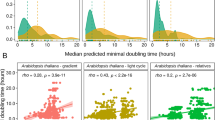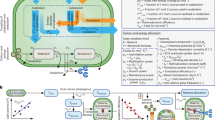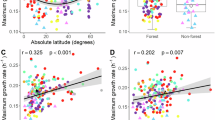Abstract
Relationships between microbial genes and performance are often evaluated in the laboratory in pure cultures, with little validation in nature. Here, we show that genomic traits related to laboratory measurements of maximum growth potential failed to predict the growth rates of bacteria in unamended soil, but successfully predicted growth responses to resource pulses: growth increased with 16S rRNA gene copy number and declined with genome size after substrate addition to soils, responses that were repeated in four different ecosystems. Genome size best predicted growth rate in response to addition of glucose alone; adding ammonium with glucose weakened the relationship, and the relationship was absent in nutrient-replete pure cultures, consistent with the idea that reduced genome size is a mechanism of nutrient conservation. Our findings demonstrate that genomic traits of soil bacteria can map to their ecological performance in nature, but the mapping is poor under native soil conditions, where genomic traits related to stress tolerance may prove more predictive. These results remind that phenotype depends on environmental context, underscoring the importance of verifying proposed schemes of trait-based strategies through direct measurement of performance in nature, an important and currently missing foundation for translating microbial processes from genes to ecosystems.
Similar content being viewed by others
Log in or create a free account to read this content
Gain free access to this article, as well as selected content from this journal and more on nature.com
or
References
Reich PB, Walters MB, Ellsworth DS. From tropics to tundra: global convergence in plant functioning. Proc Natl Acad Sci USA. 1997;94:13730–4.
Brown JH, Gillooly JF, Allen AP, Savage VM, West GB. Toward a metabolic theory of ecology. Ecology. 2004;85:1771–89.
Roller BRK, Stoddard SF, Schmidt TM. Exploiting rRNA operon copy number to investigate bacterial reproductive strategies. Nat Microbiol. 2016;1:16160.
Cox RA. Correlation of the rate of protein synthesis and the third power of the RNA: protein ratio in Escherichia coli and Mycobacterium tuberculosis. Microbiology. 2003;149:729–37.
Scott M, Klumpp S, Mateescu EM, Hwa T. Emergence of robust growth laws from optimal regulation of ribosome synthesis. Mol Syst Biol. 2014;10:747.
Lynch M. Streamlining and simplification of microbial genome architecture. Annu Rev Microbiol. 2006;60:327–49.
Hessen DO, Jeyasingh PD, Neiman M, Weider LJ. Genome streamlining and the elemental costs of growth. Trends Ecol Evol. 2010;25:75–80.
Lee M-C, Marx CJ. Repeated, selection-driven genome reduction of accessory genes in experimental populations. PLoS Genet. 2012;8:e1002651.
Wolf YI, Koonin EV. Genome reduction as the dominant mode of evolution. Bioessays. 2013;35:829–37.
Lever MA, Rogers KL, Lloyd KG, Overmann J, Schink B, Thauer RK, et al. Life under extreme energy limitation: a synthesis of laboratory- and field-based investigations. FEMS Microbiol Rev. 2015;39:688–728.
Schimel J, Balser TC, Wallenstein M. Microbial stress-response physiology and its implications for ecosystem function. Ecology. 2007;88:1386–94.
Hibbing ME, Fuqua C, Parsek MR, Peterson SB. Bacterial competition: surviving and thriving in the microbial jungle. Nat Rev Microbiol. 2010;8:15–25.
Gao J, Sasse J, Lewald KM, Zhalnina K, Cornmesser LT, Duncombe TA, et al. Ecosystem Fabrication (EcoFAB) Protocols for The Construction of Laboratory Ecosystems Designed to Study Plant-microbe Interactions. J Vis Exp. 2018;134:57170.
Williams PH, Haynes RJ. Effect of sheep, deer and cattle dung on herbage production and soil nutrient content. Grass Forage Sci. 1995;50:263–71.
Kearns PJ, Shade A. Trait-based patterns of microbial dynamics in dormancy potential and heterotrophic strategy: case studies of resource-based and post-press succession. ISME J. 2018;12:2575–81.
Nemergut DR, Knelman JE, Ferrenberg S, Bilinski T, Melbourne B, Jiang L, et al. Decreases in average bacterial community rRNA operon copy number during succession. ISME J. 2016;10:1147–56.
Niederdorfer R, Besemer K, Battin TJ, Peter H. Ecological strategies and metabolic trade-offs of complex environmental biofilms. Npj Biofilms Microbi. 2017;3:21.
Ortiz-Álvarez R, Fierer N, de los Ríos A, Casamayor EO, Barberán A. Consistent changes in the taxonomic structure and functional attributes of bacterial communities during primary succession. ISME J. 2018;12:1658–67.
Rivett DW, Scheuerl T, Culbert CT, Mombrikotb SB, Johnstone E, Barraclough TG, et al. Resource-dependent attenuation of species interactions during bacterial succession. ISME J. 2016;10:2259–68.
Wu LW, Yang YF, Chen S, Shi ZJ, Zhao MX, Zhu ZW, et al. Microbial functional trait of rRNA operon copy numbers increases with organic levels in anaerobic digesters. ISME J. 2017;11:2874–8.
Hungate BA, Mau RL, Schwartz E, Caporaso JG, Dijkstra P, van Gestel N, et al. Quantitative microbial ecology through stable isotope probing. Appl Environ Microbiol. 2015;81:7570–81.
Yarza P, Yilmaz P, Pruesse E, Glockner FO, Ludwig W, Schleifer KH, et al. Uniting the classification of cultured and uncultured bacteria and archaea using 16S rRNA gene sequences. Nat Rev Microbiol. 2014;12:635–45.
Wu ZT, Koch GW, Dijkstra P, Bowker MA, Hungate BA. Responses of ecosystem carbon cycling to climate change treatments along an elevation gradient. Ecosystems. 2011;14:1066–80.
Hayer M, Schwartz E, Marks JC, Koch BJ, Morrissey EM, Schuettenberg AA, et al. Identification of growing bacteria during litter decomposition in freshwater through H2 18O quantitative stable isotope probing. Environ Microbiol Rep. 2016;8:975–82.
Caporaso JG, Lauber CL, Walters WA, Berg-Lyons D, Lozupone CA, Turnbaugh PJ, et al. Global patterns of 16S rRNA diversity at a depth of millions of sequences per sample. Proc Natl Acad Sci USA. 2011;108:4516–22.
Morrissey EM, Mau RL, Schwartz E, Koch BJ, Hayer M, Hungate BA. Taxonomic patterns in the nitrogen assimilation of soil prokaryotes. Environ Microbiol. 2018;20:1112–9.
Caporaso JG, Kuczynski J, Stombaugh J, Bittinger K, Bushman FD, Costello EK, et al. QIIME allows analysis of high-throughput community sequencing data. Nat Methods. 2010;7:335–6.
Louca S, Doebeli M, Parfrey LW. Correcting for 16S rRNA gene copy numbers in microbiome surveys remains an unsolved problem. Microbiome. 2018;6:41.
Morrissey EM, Mau RL, Schwartz E, McHugh TA, Dijkstra P, Koch BJ, et al. Bacterial carbon use plasticity, phylogenetic diversity and the priming of soil organic matter. ISME J. 2017;11:1890–9.
Koch BJ, McHugh TA, Hayer M, Schwartz E, Blazewicz SJ, Dijkstra P, et al. Estimating taxon-specific population dynamics in diverse microbial communities. Ecosphere. 2018;9:e02090.
Stoddard SF, Smith BJ, Hein R, Roller BRK, Schmidt TM. rrnDB: improved tools for interpreting rRNA gene abundance in bacteria and archaea and a new foundation for future development. Nucleic Acids Res. 2015;43:D593–8.
Lankiewicz TS, Cottrell MT, Kirchman DL. Growth rates and rRNA content of four marine bacteria in pure cultures and in the Delaware estuary. ISME J. 2016;10:823–32.
Valdivia-Anistro JA, Eguiarte-Fruns LE, Delgado-Sapien G, Marquez-Zacarias P, Gasca-Pineda J, Learned J, et al. Variability of rRNA operon copy number and growth rate dynamics of Bacillus isolated from an extremely oligotrophic aquatic ecosystem. Front Microbiol. 2015;6:1486.
Vieira-Silva S, Rocha EPC. The systemic imprint of growth and its uses in ecological (meta)genomics. PLoS Genet. 2010;6:e1000808.
Zhu M, Dai X. On the intrinsic constraint of bacterial growth rate: M. tuberculosis’s view of the protein translation capacity. Crit Rev Microbiol. 2018;44:455–64.
Dethlefsen L, Schmidt TM. Performance of the translational apparatus varies with the ecological strategies of bacteria. J Bacteriol. 2007;189:3237–45.
R Core Team. R: A language and environment for statistical computing. Vienna, Austria: R Foundation for Statistical Computing; 2017. https://www.R-project.org/.
Muttray AF, Mohn WW. Quantitation of the population size and metabolic activity of a resin acid degrading bacterium in activated sludge using slot-blot hybridization to measure the rRNA:rDNA ratio. Microb Ecol. 1999;38:348–57.
Rosset R, Julien J, Monier R. Ribonucleic acid composition of bacteria as a function of growth rate. J Mol Biol. 1966;18:308–20.
Blazewicz SJ, Barnard RL, Daly RA, Firestone MK. Evaluating rRNA as an indicator of microbial activity in environmental communities: limitations and uses. ISME J. 2013;7:2061–8.
Papp K, Hungate BA, Schwartz E. Microbial rRNA synthesis and growth compared through quantitative stable isotope probing with H2 18O. Appl Environ Microbiol. 2018; 84, pii: e02441-17.
Demoling F, Figueroa D, Bååth E. Comparison of factors limiting bacterial growth in different soils. Soil Biol Biochem. 2007;39:2485–95.
Chirife J, Herszage L, Joseph A, Kohn ES. In vitro study of bacterial growth inhibition in concentrated sugar solutions: microbiological basis for the use of sugar in treating infected wounds. Antimicrob Agents Ch. 1983;23:766–73.
Dohi M, Mougi A. A coexistence theory in microbial communities. R Soc Open Sci. 2018;5:180476.
Sorensen JW, Dunivin TK, Tobin TC, Shade A. Ecological selection for small microbial genomes along a temperate-to-thermal soil gradient. Nat Microbiol. 2018;4:55–61.
Fierer N. Embracing the unknown: disentangling the complexities of the soil microbiome. Nat Rev Microbiol. 2017;15:579–90.
Morrissey EM, Mau RL, Schwartz E, Caporaso JG, Dijkstra P, van Gestel N, et al. Phylogenetic organization of bacterial activity. ISME J. 2016;10:2336–40.
Coyte KZ, Schluter J, Foster KR. The ecology of the microbiome: Networks, competition, and stability. Science. 2015;350:663–6.
Fierer N, Bradford MA, Jackson RB. Toward an ecological classification of soil bacteria. Ecology. 2007;88:1354–64.
Ho A, Kerckhof FM, Luke C, Reim A, Krause S, Boon N, et al. Conceptualizing functional traits and ecological characteristics of methane-oxidizing bacteria as life strategies. Environ Microbiol Rep. 2013;5:335–45.
Wright IJ, Reich PB, Westoby M, Ackerly DD, Baruch Z, Bongers F, et al. The worldwide leaf economics spectrum. Nature. 2004;428:821–7.
Acknowledgements
This work was supported by the US National Science Foundation (Dimensions of Biodiversity, DEB-1321792) and the US Department of Energy, Program in Genomic Sciences (DE-SC0016207). We thank Jingrun Sun, Zacchaeus Compson, Bri Finley, and Jeff Propster for assistance in the laboratory, and Alicia Purcell for intellectual contributions. Work at Lawrence Livermore National Laboratory (LLNL) was funded by the Department of Energy through the Genome Sciences Program under contracts SCW1024 and SCW1590, and performed under the auspices of LLNL under Contract DE-AC52-07NA27344.
Author information
Authors and Affiliations
Contributions
All authors contributed to the conceptual development of this work. BAH, XJAL, PD, ES, and RLM designed the incubation study. XJAL and RLM performed the incubation study. RLM and MH conducted the molecular analyses. RLM, BJK, ES, BAH, BWS, and EMM analyzed the qSIP data. JL developed and performed the bioinformatics analysis, the meta-analysis of growth estimates of bacteria in the laboratory, and statistical inference tests. EMM, SJB, JPR, and BWS provided additional intellectual input. BAH and JL wrote the manuscript, with editorial contributions from all authors, and particularly substantive contributions from PD, JP, EMM, and SJB.
Corresponding author
Ethics declarations
Conflict of interest
The authors declare that they have no conflict of interest.
Additional information
Publisher’s note: Springer Nature remains neutral with regard to jurisdictional claims in published maps and institutional affiliations.
Supplementary information
41396_2019_422_MOESM1_ESM.docx
Table S1 Sensitivity analyses of Table 1 comparing results across identity thresholds as described in the legend to Supplemental Figure 3.
41396_2019_422_MOESM2_ESM.docx
Table S2 Model selection for predicting bacterial growth rates based on genomic traits. All models have the genetic form: excess atom fraction 18O = copy number * slope1 + genome size * slope2 + intercept. For cases where at least one model was statistically significant, the best model is indicated in bold, underline.
41396_2019_422_MOESM3_ESM.docx
Table S3 Sensitivity analyses of Table 3 comparing results across identity thresholds as described in the legend to Supplemental Figure 3.
41396_2019_422_MOESM4_ESM.pdf
Figure S1 Comparison of estimated 16S rRNA copy number to that from the rrnDB database (https://rrndb.umms.med.umich.edu/). Source data for Supplemental Figure 1 are available at https://bitbucket.org/junhuilinau/manuscript-supplementary/src/master/.
41396_2019_422_MOESM5_ESM.pdf
Figure S2 The distribution of 16S rRNA gene copy number of each OTU used in the analysis at different percent match at the 16S locus. Grey circles represent the 16S rRNA gene copy number of each individual sequence assigned to the respective OTU; Colored circles represent the average 16S rRNA gene copy number of all sequences assigned to the respective OTU, and error bars are the 95% confidence intervals.
41396_2019_422_MOESM6_ESM.pdf
Figure S3 Sensitivity analyses of Figure 1, comparing relationships between growth and copy number, and growth and genome size, for each of the sequence identity thresholds we considered, using thresholds suggested by Yarza et al. (2014), where 94.5% corresponds to genus and 98.7% to species, and 99.5% and 100% are also recommended as match thresholds indicating closer relatedness.
Rights and permissions
About this article
Cite this article
Li, J., Mau, R.L., Dijkstra, P. et al. Predictive genomic traits for bacterial growth in culture versus actual growth in soil. ISME J 13, 2162–2172 (2019). https://doi.org/10.1038/s41396-019-0422-z
Received:
Revised:
Accepted:
Published:
Issue date:
DOI: https://doi.org/10.1038/s41396-019-0422-z
This article is cited by
-
Predictions of rhizosphere microbiome dynamics with a genome-informed and trait-based energy budget model
Nature Microbiology (2024)
-
The biogeography of soil microbiome potential growth rates
Nature Communications (2024)
-
Growth rate as a link between microbial diversity and soil biogeochemistry
Nature Ecology & Evolution (2024)
-
The predictive power of phylogeny on growth rates in soil bacterial communities
ISME Communications (2023)
-
Growth phase estimation for abundant bacterial populations sampled longitudinally from human stool metagenomes
Nature Communications (2023)



